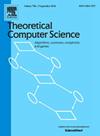Pairwise rearrangement is fixed-parameter tractable in the Single Cut-and-Join model
IF 1
4区 计算机科学
Q3 COMPUTER SCIENCE, THEORY & METHODS
引用次数: 0
Abstract
Genome rearrangement is a common model for molecular evolution. In this paper, we consider the Pairwise Rearrangement problem, which takes as input two genomes and asks for the number of minimum-length sequences of permissible operations transforming the first genome into the second. In the Single Cut-and-Join model (Bergeron et al., 2010 [3]), Pairwise Rearrangement is -complete (Bailey et al., 2024 [1]), which implies that exact sampling is intractable. In order to cope with this intractability, we investigate the parameterized complexity of this problem. We exhibit a fixed-parameter tractable algorithm with respect to the number of components in the adjacency graph that are not cycles of length 2 or paths of length 1. As a consequence, we obtain that Pairwise Rearrangement in the Single Cut-and-Join model is fixed-parameter tractable by distance. Our results suggest that the number of nontrivial components in the adjacency graph serves as the key obstacle for efficient sampling.
在单切割连接模型中,两两重排是固定参数可处理的
基因组重排是分子进化的一种常见模式。本文研究了以两个基因组为输入的成对重排问题,该问题要求将第一个基因组转化为第二个基因组的最小允许操作序列的长度。在Single Cut-and-Join模型(Bergeron et al., 2010[3])中,成对重排是#P-complete (Bailey et al., 2024[3]),这意味着精确采样是难以处理的。为了解决这一棘手问题,我们研究了该问题的参数化复杂性。我们展示了一个关于邻接图中不是长度为2的循环或长度为1的路径的组件数量的固定参数可处理算法。结果表明,单切割连接模型中的成对重排是固定参数可处理的。我们的研究结果表明,邻接图中非平凡分量的数量是有效采样的关键障碍。
本文章由计算机程序翻译,如有差异,请以英文原文为准。
求助全文
约1分钟内获得全文
求助全文
来源期刊

Theoretical Computer Science
工程技术-计算机:理论方法
CiteScore
2.60
自引率
18.20%
发文量
471
审稿时长
12.6 months
期刊介绍:
Theoretical Computer Science is mathematical and abstract in spirit, but it derives its motivation from practical and everyday computation. Its aim is to understand the nature of computation and, as a consequence of this understanding, provide more efficient methodologies. All papers introducing or studying mathematical, logic and formal concepts and methods are welcome, provided that their motivation is clearly drawn from the field of computing.
 求助内容:
求助内容: 应助结果提醒方式:
应助结果提醒方式:


